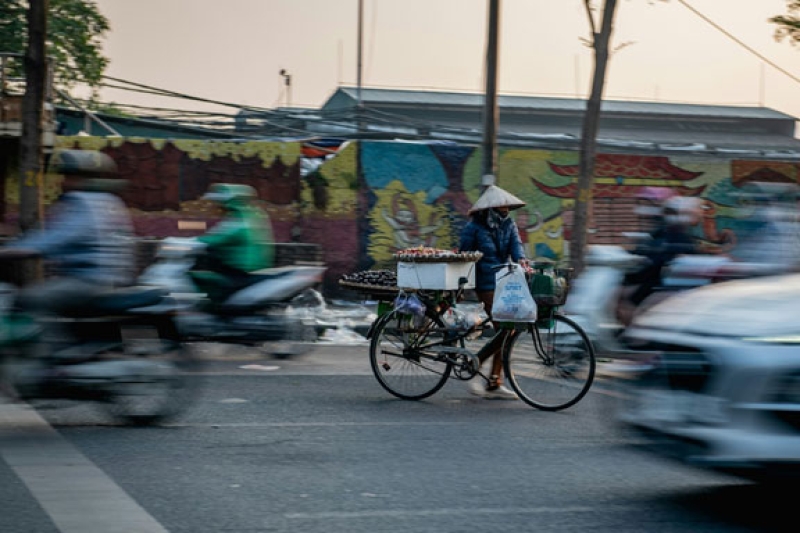- Govt to cut savings certificate profit rates from January |
- Gold prices hit fresh record in Bangladesh within 24 hours |
- Election to be held on time, Prof Yunus tells US Special Envoy |
- Moscow wants Dhaka to reduce tensions domestically, also with Delhi |
- Saarc experts meet to reduce livestock-origin greenhouse gases |
Asia-Pacific’s Policy Shifts Offer Key Development Lessons

A female merchant crosses a bustling street in Hanoi, Vietnam. Despite economic progress over five decades, development gaps in Asia and the Pacific remain. Credit: Unsplash/Jeremy Stewardson.
The Asia-Pacific region has long served as a springboard for transforming socio-economic implementation gaps into development opportunities. With the 2030 deadline for the Sustainable Development Goals fast approaching, policymakers are stepping up efforts to translate policy announcements into tangible impacts.
Looking back since the 1970s, the region’s development trajectory has been shaped by a series of crises that triggered transformative policy responses. Through strategic partnerships, countries in the region are well-positioned to promote shared prosperity for both people and the planet.
Anchoring crisis-driven policy shifts
In the 1970s, technological advances—particularly in agriculture—ushered in a new era. The introduction of high-yield crop varieties, known as the Green Revolution, boosted food production and rural incomes, laying the foundation for the emergence of a middle class. However, the decade also exposed vulnerabilities, as volatility in global commodity and energy prices highlighted the risks of external shocks.
The 1980s brought further challenges. Rising oil prices and global interest rates strained national budgets across developing countries. The cost of servicing external debt crowded out investments in productive sectors, underscoring the risks of over-reliance on foreign aid.
The 1997 Asian financial crisis marked a watershed moment. Currency collapses triggered capital flight and trade disruptions, leaving deep scars and prompting shifts in political governance and economic policy across the region.
By the early 2000s, optimism returned. Trade and investment surged, regional value chains expanded, and ICT-driven growth further integrated economies into the global system. Globalization was widely seen as a pathway to long-term prosperity.
Yet the 2008 global financial crisis shattered this optimism. Inflation soared, investor confidence plummeted, and trade contracted sharply.
Fast forward to the COVID-19 pandemic, which once again exposed deep vulnerabilities: socio-economic inequality widened, job prospects diminished, overdependence on supply chains became evident, technological monopolies were revealed, and environmental fragility was laid bare. The pandemic reinforced the urgent need for adaptive and resilient policy frameworks.
These crises underscored the importance of coordinated policy action in an interconnected world, reinforcing the lesson that growth without inclusiveness and sustainability is unsustainable.
Adjusting to changing socio-economic realities
The development journey of the Asia-Pacific region has been marked by complexity and diversity. A comparative analysis over recent decades reveals recurring challenges: volatility in energy and food prices, and tightening financial conditions have consistently tested policymakers. Rising interest rates in advanced economies have reignited debt concerns in developing countries, threatening economic stability and undermining progress.
Simultaneously, intensifying geopolitical competition is reshaping trade relations, investment flows, and technology transfers. Policymakers must navigate these shifts while pursuing national development priorities and adapting to evolving dynamics.
These pressures have prompted the region to diversify its sources of economic growth and strategic engagement. Despite impressive achievements in social development, long-term stability and impact-driven outcomes hinge on governments’ ability to manage external shocks, anticipate risks, and promote cross-border cooperation while accelerating climate action.
Recent policy shifts signal a move toward structural transformation. Governments are spearheading industrialization, accelerating green energy transitions, and pioneering sustainable financing mechanisms. This marks a transition from short-term crisis management to building medium- and long-term socio-economic progress.
The pandemic years further emphasized the need for adaptive policies—ones that can absorb unexpected shocks while maintaining progress toward stability.
Adapting through policy lessons
The development experiences of the least developed countries (LDCs), landlocked developing countries (LLDCs), and small island developing states (SIDS) offer valuable insights into building institutional capacity and preventing future crises. Four strategic policy lessons emerge:
Price stability matters:
Volatile prices have repeatedly undermined development gains. Strategic foresight and balanced economic planning are essential to safeguard progress.
Fiscal buoyancy is critical:
Excessive external borrowing has triggered past crises. Creating fiscal space, mobilizing domestic resources, scaling up blended finance, and implementing coordinated debt management frameworks are vital.
Crisis preparedness requires coordination:
The 1997 and 2008 crises showed that no country can respond effectively in isolation. Strengthening institutions is crucial for early warning systems, policy dialogue, and coordinated responses.
Sustainability is key to people-centred development:
Climate change, socio-economic disparities, and institutional inefficiencies pose long-term risks. Integrating sustainability into national strategies and promoting technological transformation are now imperative.
Turning points
The Asia-Pacific region’s development story is one of transition and transformation. Connecting these turning points reveals a region that has consistently learned from challenges and leveraged them to advance policy solutions.
The path ahead is promising, but policies must evolve to address shifting socio-economic dynamics, structural vulnerabilities, climate risks, and emerging geopolitical realignments. These efforts must be anchored in regional cooperation, inclusive dialogue, and coordinated action, particularly through platforms such as ESCAP.
While governments play a central role, long-term progress will depend on the collective engagement of the private sector, academia, civil society, and regional institutions. With strategic convergence, the Asia-Pacific region is well-positioned to overcome today’s uncertainties and shape a better future for all.
Sudip Ranjan Basu is Secretary of the Commission, ESCAP

